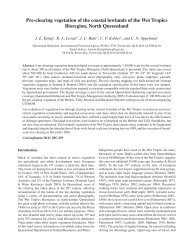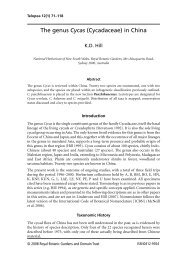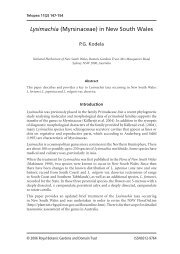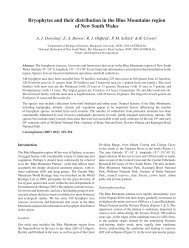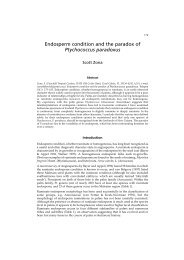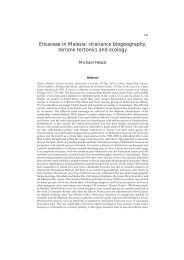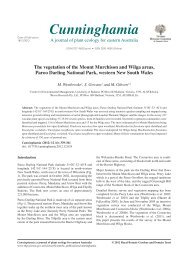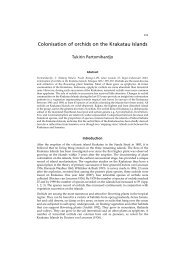Silene banksia - Royal Botanic Gardens
Silene banksia - Royal Botanic Gardens
Silene banksia - Royal Botanic Gardens
Create successful ePaper yourself
Turn your PDF publications into a flip-book with our unique Google optimized e-Paper software.
252 Telopea 8(2): 1999<br />
<strong>Botanic</strong>al and horticultural solutions<br />
All the binomials in current use for this group are thus ultimately based on cultivated<br />
plants, mostly grown away from their presumed native distribution, mainland east<br />
Asia. Based on these striking cultivated plants, botanists have insisted on keeping up<br />
distinct species (L. cognata, ‘L. fulgens’, L. senno and L. coronata in mainland Asia, and,<br />
in Japan, L. sieboldii (including L. speciosa), ‘L. fulgens’, L. senno and L. coronata<br />
(the last two as cultivated plants from China)), though, dealing with living plants,<br />
horticulturists in the last century took a very different view. After his experimental<br />
work, Ortgies (1860) concluded that the parents of L. × haageana were conspecific,<br />
confirming an opinion published the year before by K. Koch, commenting on Benary’s<br />
work (see above). Rohrbach (1869) considered L. sieboldii a ‘lusus’ of L. fulgens var.<br />
typica Regel and L. × haageana merely an intraspecific cross.<br />
British and French hortculturists, at least, effectively consolidated this, in amalgamating<br />
all the cultivated plants as varieties of one species, L. fulgens. So, Nicholson’s Illustrated<br />
Dictionary of Gardening (see below) has var. grandiflora (i.e. L. coronata, syn. L. grandiflora),<br />
var. sieboldii (i.e. L. sieboldii) and var. haageana (L. × haageana) while Désiré Bois (1896: 45–46),<br />
from his experience in the Jardin des Plantes in Paris, wrote, ‘Toutes ces plantes ne<br />
different au point de vue scientifique que par des caractères peu emportants et très<br />
variables comme le degré de villosité (abondance plus ou moins grande de poils fins<br />
et courts), le nombre des fleurs dans les inflorescences, les dimensions des pétales<br />
simplement échancrés ou plus ou moins découpés’. Contrary to perceived wisdom,<br />
then, it is horticulturists who were recognizing a smaller number of species than<br />
botanists were, and still are.<br />
Further research directions<br />
The distribution of L. coronata (L. grandiflora) has been said to be China and Japan, but<br />
I have seen no definitely wild material. If, as Siebold and Zuccarini suggested, the<br />
forms seen in Japan were, like so many cultivated Japanese plants, such as<br />
chrysanthemums, for example, selected from Chinese plants already cultivated for a<br />
long time in China, it might well be that L. coronata has a hybrid origin itself. This<br />
would certainly explain the extraordinary array of plants produced by some forms<br />
after selfing. If this is indeed so, what are the wild plants from which L. coronata has<br />
been derived? ‘L. fulgens’ is morphologically similar to the Chinese L. laciniata Maxim.<br />
(non Lam. = L. flos-cuculi L.), i.e. L. wilfordii (Regel) Maxim.(L. fulgens var. wilfordii<br />
Regel, of which Rohrbach (1869: 185) recognized two forms, the wild f. mandschurica<br />
Rohrb. from mainland Asia and f. japonica Rohrb. from cultivation in Japan). Its<br />
relationship with L. coronata needs to be examined, as does that with what has been<br />
called L. cognata Maxim. (reduced to a variety of L. fulgens by Rohrbach): if such plants<br />
represent forms of one parent species, then L × haageana would merely be a backcross<br />
between one distinctive form within the existing hybrid complex and one close to a<br />
putative wild parent. However, the possibility of other parent species being involved<br />
cannot yet be ruled out and allied wild species in both China and Japan, notably<br />
L. miqueliana Rohrb., need to be studied with this in mind.<br />
The most parsimonious hypothesis on present evidence is that ‘L. fulgens’ in<br />
cultivation is that form most like the wild type and that L. senno, true L. fulgens and<br />
L. bungeana are forms nearer it than is L. coronata, which includes Hedona sinensis,<br />
Agrostemma <strong>banksia</strong>, L. sieboldii and L. speciosa. Nonetheless, this is, as yet, hypothesis<br />
and the relationship between all these plants, and even L × arkwrightii (and therefore<br />
L. chalcedonica itself), needs clarification through controlled hybridization experiments,<br />
preferably using wild-collected material, before a definitive scheme can finally be<br />
arrived at.





